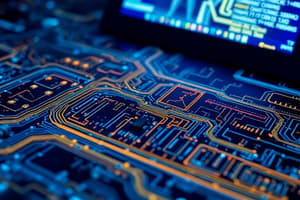Podcast
Questions and Answers
What is the primary goal of image forensics?
What is the primary goal of image forensics?
- To create visual cues for identifying AI-generated images
- To develop deep learning-based methods for image detection
- To generate AI-generated images
- To analyze and detect tampered or manipulated images (correct)
Which of the following deep learning-based methods is used to analyze image sequences?
Which of the following deep learning-based methods is used to analyze image sequences?
- Autoencoders
- Convolutional Neural Networks (CNNs)
- Recurrent Neural Networks (RNNs) (correct)
- Generative Adversarial Networks (GANs)
What type of adversarial attack has access to model parameters and training data?
What type of adversarial attack has access to model parameters and training data?
- Grey-box attack
- Transfer attack
- White-box attack (correct)
- Black-box attack
Which visual cue is often used to identify AI-generated images?
Which visual cue is often used to identify AI-generated images?
What is the purpose of error level analysis in image manipulation detection?
What is the purpose of error level analysis in image manipulation detection?
What is the primary goal of adversarial training?
What is the primary goal of adversarial training?
What is the purpose of data augmentation in the context of adversarial attacks?
What is the purpose of data augmentation in the context of adversarial attacks?
What is the primary goal of image-to-image translation in image manipulation techniques?
What is the primary goal of image-to-image translation in image manipulation techniques?
Flashcards are hidden until you start studying
Study Notes
Image Forensics
- The field of image forensics deals with the analysis and detection of tampered or manipulated images
- AI-generated images can be detected using various techniques, including:
- Noise inconsistencies
- Chroma subsampling
- JPEG compression artifacts
- Metadata analysis
- Camera response function analysis
Deep Learning Detection
- Deep learning-based methods can be used to detect AI-generated images
- Techniques include:
- Convolutional Neural Networks (CNNs) trained on large datasets of real and generated images
- Recurrent Neural Networks (RNNs) to analyze image sequences
- Generative Adversarial Networks (GANs) to generate and detect fake images
Adversarial Attacks
- Adversarial attacks are designed to deceive AI-generated image detection systems
- Types of attacks:
- White-box attacks: attacker has access to model parameters and training data
- Black-box attacks: attacker only has access to model inputs and outputs
- Grey-box attacks: attacker has partial access to model parameters and training data
- Countermeasures:
- Data augmentation
- Ensemble methods
- Adversarial training
Visual Cues
- Visual cues can be used to identify AI-generated images
- Cues include:
- Unrealistic or inconsistent lighting
- Over-smoothed or lack of texture
- Inconsistent or unrealistic reflections
- Unnatural or exaggerated facial expressions
Image Manipulation Techniques
- AI-generated images can be created using various manipulation techniques, including:
- Image-to-image translation (e.g., translating daytime images to nighttime)
- Image editing (e.g., removing or adding objects)
- Image synthesis (e.g., generating novel views of objects)
- Image manipulation detection techniques, such as:
- Error level analysis
- JPEG ghost detection
- Noise analysis
Image Forensics
- Image forensics involves analyzing and detecting tampered or manipulated images
- AI-generated images can be detected through various techniques, including:
- Analyzing noise inconsistencies
- Examining chroma subsampling
- Identifying JPEG compression artifacts
- Analyzing metadata
- Studying camera response function
Deep Learning Detection
- Deep learning-based methods can detect AI-generated images
- Techniques include:
- Training Convolutional Neural Networks (CNNs) on large datasets of real and generated images
- Using Recurrent Neural Networks (RNNs) to analyze image sequences
- Employing Generative Adversarial Networks (GANs) to generate and detect fake images
Adversarial Attacks
- Adversarial attacks aim to deceive AI-generated image detection systems
- Types of attacks include:
- White-box attacks: attacker has access to model parameters and training data
- Black-box attacks: attacker only has access to model inputs and outputs
- Grey-box attacks: attacker has partial access to model parameters and training data
- Countermeasures against attacks include:
- Data augmentation
- Ensemble methods
- Adversarial training
Visual Cues
- Visual cues can help identify AI-generated images
- Cues include:
- Unrealistic or inconsistent lighting
- Over-smoothed or lack of texture
- Inconsistent or unrealistic reflections
- Unnatural or exaggerated facial expressions
Image Manipulation Techniques
- AI-generated images can be created using various manipulation techniques, including:
- Image-to-image translation
- Image editing
- Image synthesis
- Image manipulation detection techniques, such as:
- Error level analysis
- JPEG ghost detection
- Noise analysis
Studying That Suits You
Use AI to generate personalized quizzes and flashcards to suit your learning preferences.




